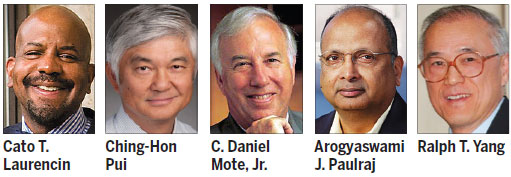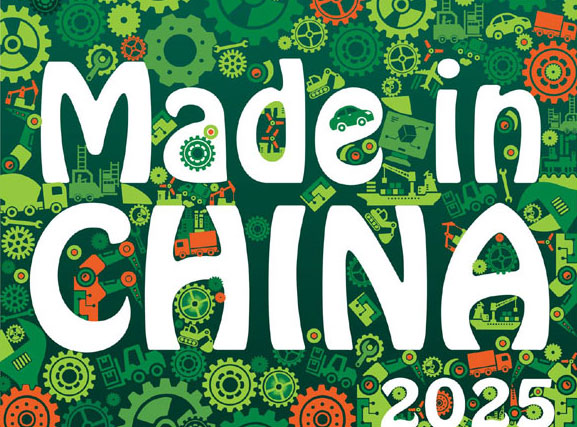US scientists picked for top China panel
Updated: 2015-12-08 11:32
By Chen Weihua in Washington and Hezi Jiang and Hong Xiao in New York(China Daily USA)
|
|||||||||||
When C.D. Mote Jr, president of the US National Academy of Engineering (NAE), was asked by China Daily on Monday to share his thoughts on becoming a foreign member of the Chinese Academy of Engineering (CAE), he said he was not aware of the news.
"I didn't even know that I was actually being considered," he said. "It's very exciting. It's extremely exciting, actually."
The CAE, one of the most prestigious academic institutions in China, announced on Monday in Beijing its newest group of 70 Chinese members and eight foreign members, often known as academicians.

The foreign members include five Americans, one Briton, one Canadian and one Austrian, bringing CAE's foreign members to 49.
Mote was on a flight home to Washington from Shanghai when the news was announced. A member of the Confucius Institute Headquarters Council, Mote was in China for a CI conference.
In 2004, the University of Maryland, where Mote served as president from 1998 to 2010, launched the first Confucius Institute, which now has grown to 500 worldwide.
Mote has been active in China since the early 1990s as vice-chancellor of the University of California-Berkeley. He described the then-Chancellor Chang-Lin Tien, who passed away in 2002, as very engaged with China.
"It has been my favorite country to work with, observe and participate in some ways, helping it to develop," he said.
He called CAE and NAE very good partners. "Of any academies in the world, I would say CAE is probably the academy we do the most work with," said Mote, 78, who was elected NAE president in 2013 for six years.
Over the past 25 years, Mote has worked as an economic adviser to Jiangsu province Party secretary Liang Baohua, and an honorary professor at Harbin Institute of Technology and Beijing Normal University.
Mote said there are very strong and capable people at CAE, and much original and world-leading work being done.
"It's only going to get better, better and better, because of the scale and the talents, the national focus on it. It's very impressive," he said.
A mechanical engineering scientist, Mote said it's important that the US and China are focused together on major issues of the world. "That's been my goal for years, to develop much better human relations, national relations and understandings between people. That's why I like the Confucius Institute program so much," he said.
Like Mote, Ching-Hon Pui, 64, chairman of the Department of Oncology at St Jude Children's Research Hospital in Memphis, Tennessee, has been involved in programs in China for more than 20 years, with Shanghai Children's Medical Center and Beijing Children's Hospital.
"Curing children with leukemia is my lifelong passion and dream. So I am really grateful having the opportunity to work with Chinese counterparts all these years," Pui said.
Pui believes that being a foreign member of CAE means a great deal "because now activities and collaboration in China can be greatly facilitated".
About 10 years ago, Pui was struck by the sight in China of a mother crying in a hospital because she could not afford treatment for her child suffering from leukemia.
Pui described St Jude, where he has worked for 39 years, as a place to realize his dream to cure child leukemia. With China's fast growth and a better insurance system, prospects for leukemia patients in China have improved.
Pui believes Chinese and American doctors are very complementary. "We can do a whole lot more together for the children around the world," he said.
Pui said he is communicating with Chinese counterparts almost daily.

Arogyaswami Paulraj, a professor emeritus of engineering at Stanford University, said "it's a very great honor it's selective", when talking about his becoming a CAE member.
Known as the key inventor of a breakthrough wireless technology called MIMO (multiple input multiple output), Paulraj has been involved with China for several years.
He has taught classes at Beijing University of Posts and Telecommunications (UPT) and advised PhD students on their theses. He also regularly goes to China for keynote talks at conferences, often on 5G, which he said will be out in five or six years, and China may be an important player.
Paulraj, 71, said: "2G was primarily from Europe; 3G, the United States began to share the dominance with Europe; 4G was very much a US technology, partly because MIMO is invented here," said Paulraj. "Who knows, 5G may be led by China. China is very dominant in the research. [The honor] will certainly increase my relationship with China."
Ralph Yang, 73, a professor of chemical engineering at the University of Michigan, believes the exchanges between him and China will increase now.
Yang was in China in October for academic conferences in Beijing, Shanghai and Henan, the provincial capital of Luoyang. "I'm more than delighted to do something for China, to do anything for China," said Yang.
The fifth new US member at CAE, Cato Laurencin, former dean of University of Connecticut School of Medicine, could not be reached.
Contact the writers at chenweihua@chinadailyusa.com
(China Daily USA 12/08/2015 page1)
Today's Top News
Beijing issues first red alert for heavy air pollution
Obama vows to defeat terrorist threat
Man charged over 'terrorist incident' at London metro
10 major programs to boost China-Africa co-op
Putin sees positive trends in Russia's economy
Russian and Turkish finance ministers hold talks
Xi in South Africa to boost China-Africa cooperation
SOEs face headwinds as 21% witness profits decline
Hot Topics
Lunar probe , China growth forecasts, Emission rules get tougher, China seen through 'colored lens', International board,
Editor's Picks

|

|

|

|

|

|






